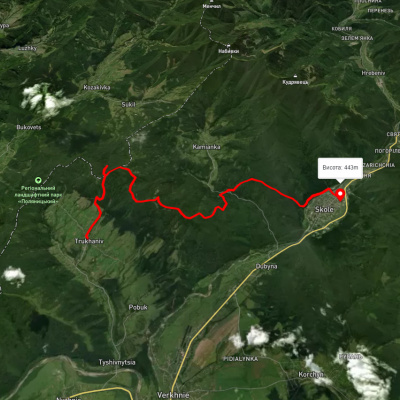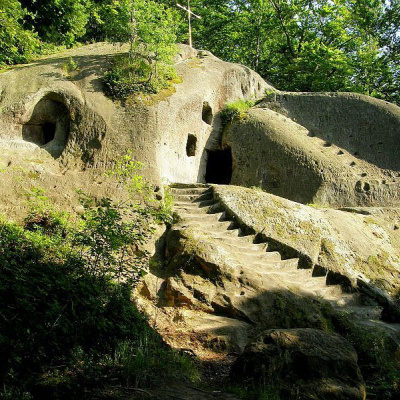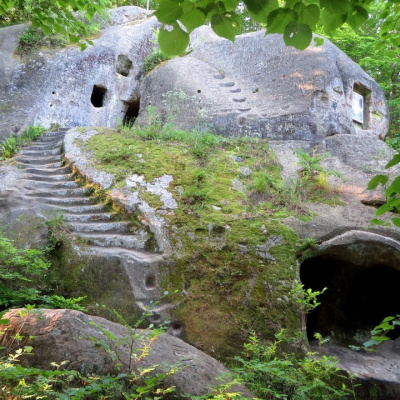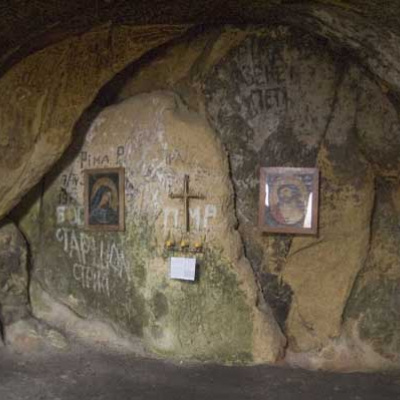"Rock and Cave Monastery in Rozgirche
When traveling in western Ukraine, don't forget to check out the small village of Rozgirche in the Lviv region. Nearby, across the Stryi River, there is a small mountain range. It hides an ancient monument that is atypical for Galicia - a cave monastery.
It is located on the southeastern outskirts of the village of Rozgirche (Stryi district, Lviv region), in the Rozgirche tract of the same name, on the territory of the Rozgirche reserve tract established in 1984. "The Rozgirche Rock Monastery lies at an altitude of 443 meters above sea level. These are rocky sandstone outcrops up to 25 meters high, formed more than 70 million years ago at the bottom of the Paleogene sea. The 50-meter-wide stone labyrinth of the Vyhorodsky sandstone outcrop stretches almost 400 meters from east to west among the beech and spruce forest.
At the foot of the mountain range there is a cave monastery in Rozgirch. The first mention of it dates back to 1460 and 1469. From the 14th to the 17th century, the monastery belonged to the Basilian Fathers. Most of the monks took a vow of silence and did not communicate with each other. With their permission, local residents could come to the cave monastery on holidays. It is also known that these monks earned their living by selling honey from their own apiary. Go inside the temple. There you will see inscriptions carved on the stone, various symbols and faces of saints.
Although the first mention of a cave monastery in Rohirch dates back to the 15th century, there is a version that these rocks were used in pagan times. During an archaeological expedition in 1990, an agricultural settlement dating back to the 8th-7th century BC was discovered near the church in the rock. According to peasants, the monastery itself was a male monastery. It is likely that its founders were monks who fled from Kyiv and other settlements of Kievan Rus destroyed by the Tatars in 1200. The surviving monks reached these lands, settled down, and, according to researchers, found an inconspicuous, hard-to-reach place and carved their monastery into the rocks.
The monks, for the most part, led a silent lifestyle, that is, they did not communicate with each other. On holidays, villagers could come to them, of course, with their permission. It is also known that the monks sold honey from a nearby apiary to earn money. Berries and mushrooms grew around the monastery, and the monks ate them.
The location was very convenient and safe, because at that time the Tatars raided Ukrainian villages and lands and burned them (this happened more than once to the village of Rozgirche). The rock massif itself is located at the foot of the ridge, on its northern slope, so the monastery, located on a hill in the forest and 200 meters from the southeastern outskirts of the village, was difficult to reach for attackers.
- When you are in the lower tier, you will immediately notice that there is one large and one small room. Researchers believe that monks' cells were located here. The smaller room most likely served as a storage room. There is a small round window on one of the walls.
- Eighteen carved stairs lead to the second tier. There was a church there. Archaeologists have found that the church building consists of a narthex, or narthex, the main part and the altar. Thus, the church was a three-part church. There are various niches in the walls of the ancient shrine.
To get to the village of Rozgirche, start your journey from Lviv. Take a train or minibus heading towards Stryi and get to the turnoff to Nyzhnia Stryina. From there, walk to the Stryi River, cross it on a long metal bridge, and you will find yourself in Rozgirche. To the east of it, after passing a local church, there will be an entrance to a cave temple. It is best to visit the cave monastery in Rozgirch in the warm season. From the height of the cave monastery complex, you will have a magnificent view of the green valley of the Stryi River.
Accommodation around "Rock and Cave Monastery in Rozgirche:
Nearby hiking trails near "Rock and Cave Monastery in Rozgirche:
Які маршрути проходять повз "Rock and Cave Monastery in Rozgirche?
Пропонуємо пройти такі туристичні (пішохідні) маршрути через/біля "Rock and Cave Monastery in Rozgirche: с. Труханів, через г. Ключ, оз. Журавлине, вдсп. Кам'янка до м. Сколе, м. Сколе, через г. Парашка, вдсп. Гуркало, с. Корчин до с. Верхнє Синьовидне, м. Сколе, через г. Парашка, вдсп. Гуркало, с. Корчин до с. Верхнє Синьовидне, м. Сколе, через г. Парашка, вдсп. Гуркало, с. Корчин до м. Сколе, м. Сколе, через г. Лопата, вдсп. Кам'янка до с. Дубина, м. Сколе, через г. Лопата, г. Хом, с. Кам'янка, вдсп. Кам'янка, с. Дубина до м. Сколе








